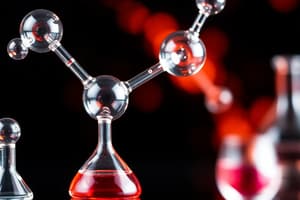Podcast
Questions and Answers
What is the primary source of inorganic compounds?
What is the primary source of inorganic compounds?
- Mineral sources (correct)
- Plant extracts
- Animal byproducts
- Living organisms
What is a characteristic of inorganic compounds?
What is a characteristic of inorganic compounds?
- They are often solids at room temperature (correct)
- They are often liquids at room temperature
- They are always non-polar covalent
- They are always ionic
What type of inorganic compound donates a proton (H+)?
What type of inorganic compound donates a proton (H+)?
- Acid (correct)
- Base
- Oxide
- Salt
What is the reaction between an acid and a base called?
What is the reaction between an acid and a base called?
What is an example of an inorganic compound used in the production of battery electrodes?
What is an example of an inorganic compound used in the production of battery electrodes?
What is a common application of inorganic compounds in industry?
What is a common application of inorganic compounds in industry?
What is a common inorganic compound found in soaps and detergents?
What is a common inorganic compound found in soaps and detergents?
What is a mixture of inorganic compounds used in construction?
What is a mixture of inorganic compounds used in construction?
Flashcards are hidden until you start studying
Study Notes
Inorganic Chemistry
Definition
- Branch of chemistry that deals with the study of inorganic compounds, which are typically derived from mineral sources
- Inorganic compounds are typically synthesized from mineral sources, such as rocks and minerals, rather than from living organisms
Characteristics
- Inorganic compounds often have high melting and boiling points
- They are typically solids at room temperature
- Inorganic compounds are often ionic or polar covalent compounds
- They can be synthesized through various methods, including precipitation, neutralization, and oxidation-reduction reactions
Types of Inorganic Compounds
- Acids: inorganic compounds that donate a proton (H+)
- Examples: sulfuric acid (H2SO4), hydrochloric acid (HCl)
- Bases: inorganic compounds that accept a proton (H+)
- Examples: sodium hydroxide (NaOH), calcium hydroxide (Ca(OH)2)
- Salts: inorganic compounds formed through the reaction of an acid and a base
- Examples: sodium chloride (NaCl), calcium carbonate (CaCO3)
- Oxides: inorganic compounds containing oxygen
- Examples: silicon dioxide (SiO2), aluminum oxide (Al2O3)
Importance of Inorganic Chemistry
- Inorganic compounds have a wide range of applications in industries such as:
- Pharmaceuticals
- Materials science
- Electronics
- Energy storage and production
- Inorganic compounds are used in various consumer products, including:
- Soaps and detergents
- Fertilizers
- Pigments
- Catalysts
Examples of Inorganic Compounds in Daily Life
- Cement: a mixture of inorganic compounds, including calcium oxide, silicon dioxide, and aluminum oxide, used in construction
- Glass: a mixture of inorganic compounds, including silicon dioxide, sodium oxide, and calcium oxide, used in windows and containers
- Batteries: inorganic compounds, such as lithium cobalt oxide, are used in the production of battery electrodes
Inorganic Chemistry
Definition and Scope
- Deals with the study of inorganic compounds, typically derived from mineral sources
- Inorganic compounds are synthesized from mineral sources, unlike organic compounds which are derived from living organisms
Characteristics of Inorganic Compounds
- Typically have high melting and boiling points
- Are usually solids at room temperature
- Can be ionic or polar covalent compounds
- Can be synthesized through various methods, including precipitation, neutralization, and oxidation-reduction reactions
Types of Inorganic Compounds
Acids
- Donate a proton (H+)
- Examples: sulfuric acid (H2SO4), hydrochloric acid (HCl)
Bases
- Accept a proton (H+)
- Examples: sodium hydroxide (NaOH), calcium hydroxide (Ca(OH)2)
Salts
- Formed through the reaction of an acid and a base
- Examples: sodium chloride (NaCl), calcium carbonate (CaCO3)
Oxides
- Contain oxygen
- Examples: silicon dioxide (SiO2), aluminum oxide (Al2O3)
Importance and Applications
- Inorganic compounds have a wide range of applications in industries such as:
- Pharmaceuticals
- Materials science
- Electronics
- Energy storage and production
- Used in various consumer products, including:
- Soaps and detergents
- Fertilizers
- Pigments
- Catalysts
Examples of Inorganic Compounds in Daily Life
- Cement: a mixture of inorganic compounds, including calcium oxide, silicon dioxide, and aluminum oxide, used in construction
- Glass: a mixture of inorganic compounds, including silicon dioxide, sodium oxide, and calcium oxide, used in windows and containers
- Batteries: inorganic compounds, such as lithium cobalt oxide, are used in the production of battery electrodes
Studying That Suits You
Use AI to generate personalized quizzes and flashcards to suit your learning preferences.



